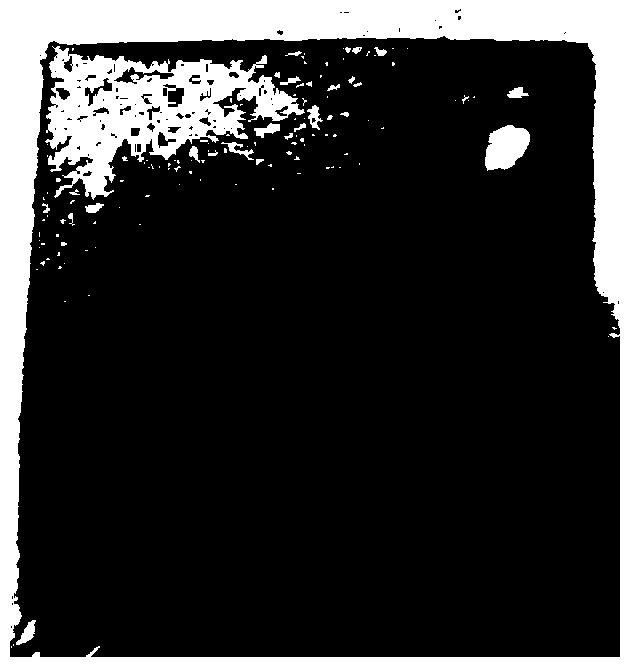Method for preparing steady-persistence luminous ceramic membrane through aluminum or aluminum alloy surface micro-arc oxidation
An aluminum alloy surface, long afterglow technology, applied in anodizing and other directions, can solve problems such as poor corrosion resistance, and achieve the effects of long service life, strong light storage, and good corrosion resistance
- Summary
- Abstract
- Description
- Claims
- Application Information
AI Technical Summary
Problems solved by technology
Method used
Image
Examples
Embodiment 1
[0028] In this embodiment, the method for preparing a long-lasting luminescent ceramic film by micro-arc oxidation on the surface of aluminum or aluminum alloy includes the following steps:
[0029] Step 1. Prepare a strontium salt system electrolyte with deionized water as a solvent. Each liter of electrolyte contains 15g of strontium carbonate, 10g of ammonium bifluoride, 10g of ammonium fluoride, 10g of diammonium hydrogen phosphate, 10g of potassium dihydrogen phosphate, and 12mL of glycerol. Adjust the pH value of the electrolyte to 7, then place the electrolyte in the electrolytic cell and let it stand for 24 hours;
[0030] Step 2. Place the aluminum alloy to be treated in the electrolyte solution described in step 1 as the anode, and the stainless steel plate as the cathode, using a micro-arc oxidation pulse power supply, and the pulse frequency is 550Hz, and the duty cycle is 15% under the condition of The aluminum alloy is subjected to micro-arc oxidation treatment. ...
Embodiment 2
[0041] The preparation method of this embodiment is the same as that of Example 1, except that the strontium salt is strontium hydroxide, strontium sulfate or strontium nitrate, or at least one of strontium carbonate, strontium hydroxide, strontium sulfate and strontium nitrate two kinds.
[0042] In this example, by using an electrolyte solution added with strontium salt, the surface of the aluminum alloy after micro-arc oxidation treatment is formed to contain SrAl 2 o 4 The long afterglow luminescent ceramic film, after the surface of the aluminum alloy is irradiated with visible light, it can emit fluorescence continuously for more than 24 hours in a dark place. At the same time, when the ceramic film formed on the surface of the aluminum alloy after the micro-arc oxidation treatment in this embodiment is not subjected to post-sealing treatment, the corrosion resistance of the ceramic film to neutral NaCl salt spray can reach more than 600h, and the microhardness can reac...
Embodiment 3
[0044] In this embodiment, the method for preparing a long-lasting luminescent ceramic film by micro-arc oxidation on the surface of aluminum or aluminum alloy includes the following steps:
[0045] Step 1. Use deionized water as a solvent to prepare a strontium salt system electrolyte. Each liter of electrolyte contains 22g of strontium nitrate, 12g of ammonium hydrogen fluoride, 11g of ammonium fluoride, 20g of diammonium hydrogen phosphate, 20g of potassium dihydrogen phosphate, and 5mL of glycerin. Adjust the pH value of the electrolyte to 7, then place the electrolyte in the electrolytic cell and let it stand for 24 hours;
[0046] Step 2. Place the aluminum to be treated in the electrolyte solution described in step 1 as the anode, and the stainless steel plate as the cathode. Using a micro-arc oxidation pulse power supply, the pulse frequency is 500Hz, and the duty ratio is 20% for the aluminum Perform micro-arc oxidation treatment. First, constant-voltage micro-arc oxi...
PUM
| Property | Measurement | Unit |
|---|---|---|
| microhardness | aaaaa | aaaaa |
Abstract
Description
Claims
Application Information
 Login to View More
Login to View More - R&D Engineer
- R&D Manager
- IP Professional
- Industry Leading Data Capabilities
- Powerful AI technology
- Patent DNA Extraction
Browse by: Latest US Patents, China's latest patents, Technical Efficacy Thesaurus, Application Domain, Technology Topic, Popular Technical Reports.
© 2024 PatSnap. All rights reserved.Legal|Privacy policy|Modern Slavery Act Transparency Statement|Sitemap|About US| Contact US: help@patsnap.com










